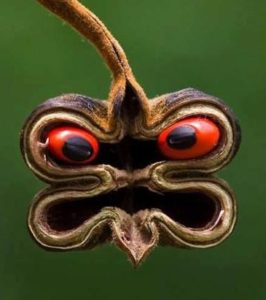
Seeds Feed the World . . . from rice to corn to beans! Seeds look dead, but they are little packages of life. They may be small as a speck of dust or large as a football. There are small seeds that produce large plants and large seeds that produce small plants. The average size of a seed is about the size of a rice kernel.
Seeds come in many different kinds of seed packages. Some contain one seed and some contain thousands. Seeds may be covered by a husk (corn), skin (cherry), pod (pea), rind (lemon), peel (banana), shell (nut), or hull (grain). Seeds may also be inside a pit or stone such as in the peach or cherry.
Some seeds grow quickly and some grow very slowly. Some die if planted too deep. Some require a freeze and some constant warmth or great heat to sprout.
Seeds travel in ingenious ways. They travel as food, are carried by wind or ocean, shot out of a pod, buried by animals, or have barbs, hooks, or spines that stick to things. Some seeds have wings and hair.
For a seed to grow it needs the right amount of water, soil, and sun. Seeds have a tiny plant inside, the embryo, with one or two seed leaves (the cotyledons.) All seeds have an endosperm, food for the new plant until it is established.
Seeds with hard seed coats can be soaked overnight to soften them for sprouting Okra and moonflower are seeds I always soak. Seeds have seed coats and water causes the seed to swell inside creating pressure that cracks open the coat for the sprout to grow. First, a tiny root is sent down into the earth to drink water and get nutrients. Then a little stem reaches out for the sky and 2 small leaves (cotyledons) appear.
Mostly insects pollinate flowers and then fertilization occurs. A yellow pollen grain from the stamen of the flower lands on the pistil and grows a tube down to the ovary of the flower that holds the ovules or eggs. An ovule is fertilized and a seed is formed.
Some seeds stay dormant through the winter till spring comes. Scientists have been able to sprout seeds dormant for a very long time. You can also propagate new plants from older plant parts of stem, root or leaf cuttings and from layering (just put a little dirt and a rock on a limb of rosemary or thyme.)
Why did the seed shiver? Because it lost its coat.
Starting seeds indoors gives you earlier vegetables and flowers and cultivar choices are endless. Gather containers, soil mix, watering can, marking pen, and seeds. Soaking seeds with hard coats like peas or okra overnight before planting shortens sprouting time.
Choose containers with good drainage. Once seedlings form true leaves they need space for root growth. Peat pots, newspaper pots, cardboard tubes, or soil blocks go right into the soil.
Potting Mix – Combine equal parts compost and vermiculite.
Seed-Starting Mix
one part vermiculite or perlite
one part peat moss,
milled sphagnum moss
compost.
Moisten soil with warm water; fill containers and plant seeds! Space large seeds 1 inch apart, medium seeds ½ to 1 inch, and tiny seeds ½ inch. Sprinkle small seeds evenly: Take a pinch of seeds and slowly rotate to release the seeds or scatter fine seeds from a saltshaker.
Cover the seeds to a depth of three times their thickness by sprinkling with light dry soil and gently pat the surface. Label before mix-ups. Put the containers in a warm place and mist the soil until they sprout or set the pots in shallow containers of water. Once they develop true leaves, transplant.
Why did the seed shiver? Because it lost its coat.
From left to right: Black Oak, Valley Oak, Q. Oregon Oak, Coast Live Oak, Blue Oak, Tan Oak, Canyon Live Oak.

Our Dwindling Food Variety
As we’ve come to depend on a handful of commercial varieties of fruits and vegetables, thousands of heirloom varieties have disappeared. It’s hard to know exactly how many have been lost over the past century, but a study conducted in 1983 by the Rural Advancement Foundation International gave a clue to the scope of the problem. It compared USDA listings of seed varieties sold by commercial U.S. seed houses in 1903 with those in the U.S. National Seed Storage Laboratory in 1983. The survey, which included 66 crops, found that about 93 percent of the varieties had gone extinct.
